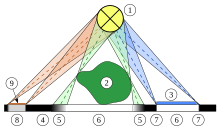Photogram
This article needs additional citations for verification. (October 2008) |

A photogram is a photographic image made without a camera by placing objects directly onto the surface of a photo-sensitive material such as photographic paper and then exposing it to light. The result is a negative shadow image varying in tone, depending on the transparency of the objects used. Areas of the paper that have received no light appear white; those exposed through transparent or semi-transparent objects appear grey.[1]
Artistic cameraless photography, as the technique producing photograms is usually known, is perhaps most prominently associated with Man Ray and his exploration of rayographs. Others who have experimented with the technique include László Moholy-Nagy, Christian Schad (who called them "Schadographs"), Imogen Cunningham and even Pablo Picasso.[2] Varieties of the technique have also been used for scientific and other purposes.
History

Some of the first known photographic images made were photograms. William Henry Fox Talbot called these photogenic drawings, which he made by placing leaves and pieces of material onto sensitised paper who got, then leaving them outdoors on a sunny day to expose, making an overall dark background and a white outline of the object used.[3]
From 1843, Anna Atkins produced British Algae: Cyanotype Impressions in installments, the first book illustrated with photographs. The images were exclusively photograms of botanical specimens. Atkins used Sir John Herschel's cyanotype process, which yields blue images. [4] This unique book can be seen in the National Media Museum in Bradford, England. [citation needed]
Man Ray's rayographs

Photograms were used in the 20th Century by a number of photographers, particularly Man Ray, who called them "rayographs". His style included capitalizing on the stark and unexpected effects of negative imaging, unusual juxtapositions of identifiable objects (such as spoons and pearl necklaces), varying the exposure time given to different objects within a single image, and moving objects as they were exposed.[citation needed]
Procedure

Like all photographic processes, photograms require light. The most commonly used source of light for this purpose is the enlarger used in conventional negative printing, but any light source can be used. The figure on the right shows how the image is formed. In the traditional darkroom setting, the paper is held in place using a printing frame. The objects to be used in making the image are placed on top of the paper. When a suitable composition has been found, the enlarger is used to expose the paper (tests will have to be done to check the exposure time and aperture required). Finally, the paper is processed, as normal, in print-developing chemicals, and washed and dried.[citation needed]
List of notable photographers using photograms
- Susan Derges
- Adam Fuss
- Raoul Hausmann
- Len Lye
- Laszlo Moholy-Nagy
- Pablo Picasso
- Man Ray
- Alexander Rodchenko
- Christian Schad
References
- ^ Langford, Michael (1999), Basic Photography (7th ed.), Oxford: Focal Press, ISBN 0 240 51592 7
- ^ According to Alexandra Matzner in Christian Schad 1895-1982 Retrospectief issued by the Gemeentemuseum Den Haag (2009), ISBN 978-3-87909-974-0, p. 216, Schad was the first artist to use the photogram technique, developed by William Henry Fox Talbot. The photogram was applied by Man Ray, Moholy-Nagy and Chargesheimer after its introduction by Christian Schad, according to the author. However, this is not substantiated through further reference by Matzner. The Dutch catalogue was also issued in German by the Leopold Museum in Vienna (2008).
- ^ Talbot, William Henry Fox (1844). The Pencil of Nature. London: Special Collections Department, Library, University of Glasgow. Retrieved 21 November 2010.
- ^ "Anna Atkins". vam.ac.uk. Retrieved 21 November 2010.
